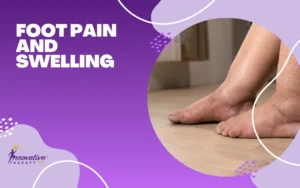Sacroiliac Joint Dysfunction, a term that may sound complex, can become a severe problem for many individuals.
In our everyday movements, we rely on our joints to be in perfect sync, and the sacroiliac joint plays a significant role in our mobility.
At Innovative Therapy PC, we’re passionate about understanding joint dysfunction, particularly in the lower back area, and how it affects our lives.
Through this guide, we aim to shed light on the complexities of this condition and how we can overcome it together.
What is the SI Joint Dysfunction?
Understanding the Sacroiliac Joint
The Sacroiliac (SI) joint is a small but crucial link between the spine and the pelvis.
It’s a gliding joint that moves back and forth while also providing a shock-absorbing effect. This connection ensures the smooth transfer of forces from the upper body to the lower limbs.
When Dysfunction Occurs
The term “dysfunction” in SI joint dysfunction implies that the joint is either too mobile or not mobile enough.
The result is often pain or discomfort in the lower back, which can radiate to the hips or legs. This dysfunction can make daily activities like walking or standing painful and difficult.
If you’ve ever wondered why SI joint dysfunction causes such discomfort, it’s because of this collaborative’s essential role in overall mobility.
What Causes SI Joint Pain?

Osteoarthritis
As we age, the cartilage’s wear and tear that cushions the SI joint can lead to osteoarthritis. It may manifest as chronic stiffness and pain.
Being a degenerative condition, early detection and treatment are crucial to manage the symptoms effectively.
Ankylosing Spondylitis
Ankylosing Spondylitis can lead to stiffness and pain in the lower back, affecting the SI joint over time.
It’s an inflammatory condition, meaning that the body’s immune response damages the tissues of the joint.
Specialized care and medication can help control inflammation and preserve joint function.
Gout
Gout, a type of arthritis, occurs when urate crystals accumulate in the joint.
This build-up can lead to sudden and severe pain, redness, and swelling.
Diet and lifestyle modifications often play a significant role in managing gout and medication.
Injury
Any direct injury to the SI joint, such as a fall or collision, can lead to dysfunction.
The physical trauma may cause inflammation, misalignment, or fractures, contributing to chronic pain and discomfort.
Pregnancy
During pregnancy, the body releases hormones that enable the ligaments to relax in preparation for childbirth.
This relaxation, combined with the weight and positional changes, can place additional stress on the SI joint.
Walking Patterns
Your walking pattern, or gait, can affect the SI joint significantly.
An uneven pace puts extra pressure on one side of the joint, leading to dysfunction over time.
Physical therapy can often correct these issues by strengthening weak muscles and retraining movement patterns.
Preventing SI Joint Pain

Prevention is critical to managing SI joint dysfunction. At Innovative Therapy PC, we believe in the following preventive strategies:
- Regular Exercise: A targeted exercise routine helps maintain joint health. Specific sacroiliac joint dysfunction exercises may include stretching and strengthening exercises to keep the joint flexible and robust.
- Proper Posture: Maintaining correct posture ensures that the entire body, including the SI joint, is aligned and functions optimally. Educating oneself about adequate sitting, standing, and lifting techniques can prevent undue stress on the joint.
- Healthy Weight Management: Excess weight can put additional pressure on the joints, including the SI joint. A balanced diet and regular exercise can aid in maintaining a healthy weight, thus preventing joint strain.
Symptoms of SI Joint Pain
Identifying SI joint dysfunction can be challenging due to the various symptoms that might occur. Key symptoms include:
- Lower Back Pain: This is often the first sign. The pain might be sharp or dull, constant or intermittent.
- Radiating Pain: The pain may radiate down to the hips, buttocks, or thighs, often confused with other conditions like sciatica.
- Stiffness: A feeling of stiffness or burning in the pelvic area, hindering movement.
- Difficulty with Certain Movements: Activities like climbing stairs, sitting for long periods, or even turning in bed might become painful.
Diagnosing SI Joint Problems
Diagnosis begins with thoroughly understanding the patient’s medical history and a physical examination.
Several stages might include:
- Physical Examination: Specialized tests that manipulate the joint and surrounding structures to identify the pain source.
- Imaging: X-rays, CT scans, or MRIs might be used to get a detailed view of the joint and rule out other potential causes.
- Diagnostic Injections: Injecting a local anesthetic into the SI joint can confirm the diagnosis if it results in pain relief.
Treatment SI Joint

Therapy, Exercise, and Self-care
Physical therapy, customized exercises, and self-care techniques are often the first line of treatment.
This approach emphasizes restoring normal function through targeted exercises, manual therapies, and home care strategies.
Medication and Nonsurgical Therapies
Medication, such as over-the-counter pain relievers or prescription medications, might be required to manage pain.
Nonsurgical therapies like injections can also be effective in providing relief.
Surgery
In some severe cases, surgical intervention might be considered when conservative treatments are ineffective.
The surgery aims to stabilize the joint, performed only after carefully considering the benefits and potential risks.
Also Read:
- Ultimate SI Joint Pain Guide: Discover Causes, Symptoms, Prevention, Diagnosis, and Proven Treatment Solutions
- An In-Depth Look at Sacroiliac (SI) Joint Pain Treatment Options at Innovative Therapy PC
FAQs About Sacroiliac Joint Dysfunction
How do you fix sacroiliac joint dysfunction?
Fixing SI joint dysfunction requires a multi-dimensional approach.
From physical therapy to surgical intervention, the treatment plan must be tailored to the individual’s condition, lifestyle, and preferences.
At Innovative Therapy PC, we pride ourselves on creating personalized treatment plans to meet our patient’s unique needs.
What does sacroiliac joint dysfunction feel like?
It feels like pain in the lower back that might spread to the hips, buttocks, or thighs.
It might be accompanied by stiffness, difficulty moving, and decreased overall quality of life. The pain may be sharp and sudden or dull and chronic, depending on the underlying cause.
How severe is sacroiliac joint dysfunction?
Though it might start as a minor inconvenience, if left untreated, SI joint dysfunction can lead to chronic pain and disability.
Early diagnosis and appropriate intervention can prevent this outcome and restore optimal function.
What causes dysfunctional sacroiliac joints?
The causes vary widely, from degenerative diseases like osteoarthritis to acute injuries or systemic conditions like ankylosing spondylitis.
A comprehensive evaluation by healthcare professionals specializing in this field is essential to pinpoint the exact cause.
Conclusion
Sacroiliac joint dysfunction is not just a medical term; it’s a condition affecting many’s quality of life.
Understanding the causes, symptoms, and treatment options is the first step toward managing this condition effectively.
At Innovative Therapy PC, we aim to offer individualized, compassionate care to our patients, utilizing the latest advancements in diagnostics and treatment.
Our commitment to education, prevention, and therapy ensures that you’re in the best hands for your journey toward recovery.
For more information or to schedule an appointment, contact us at (214) 225-8530 or email [email protected].





